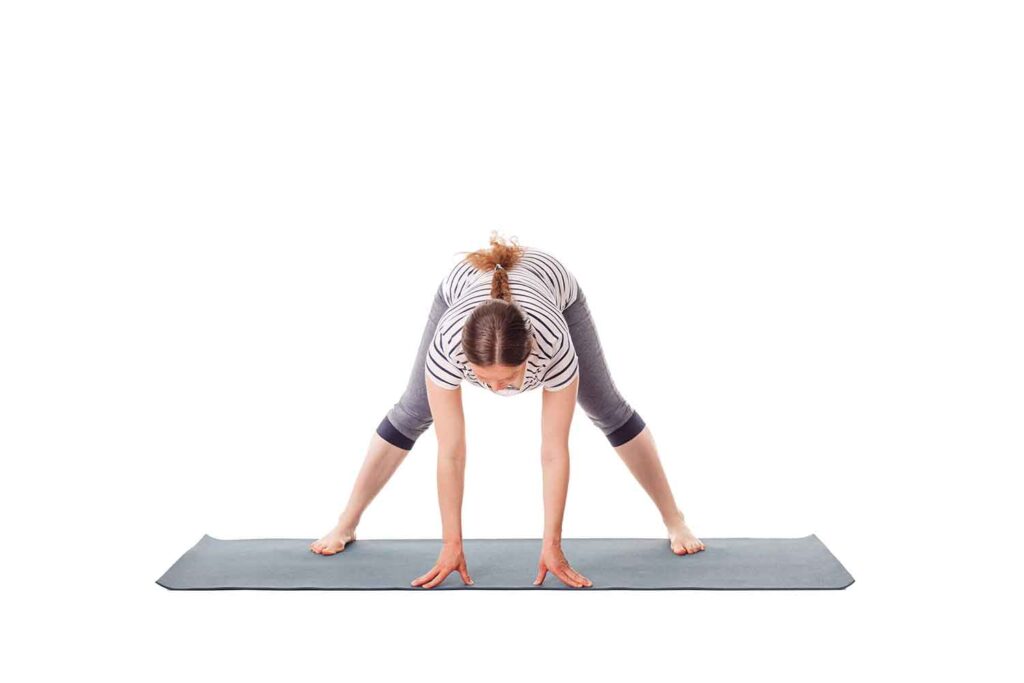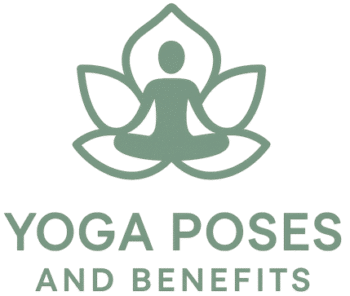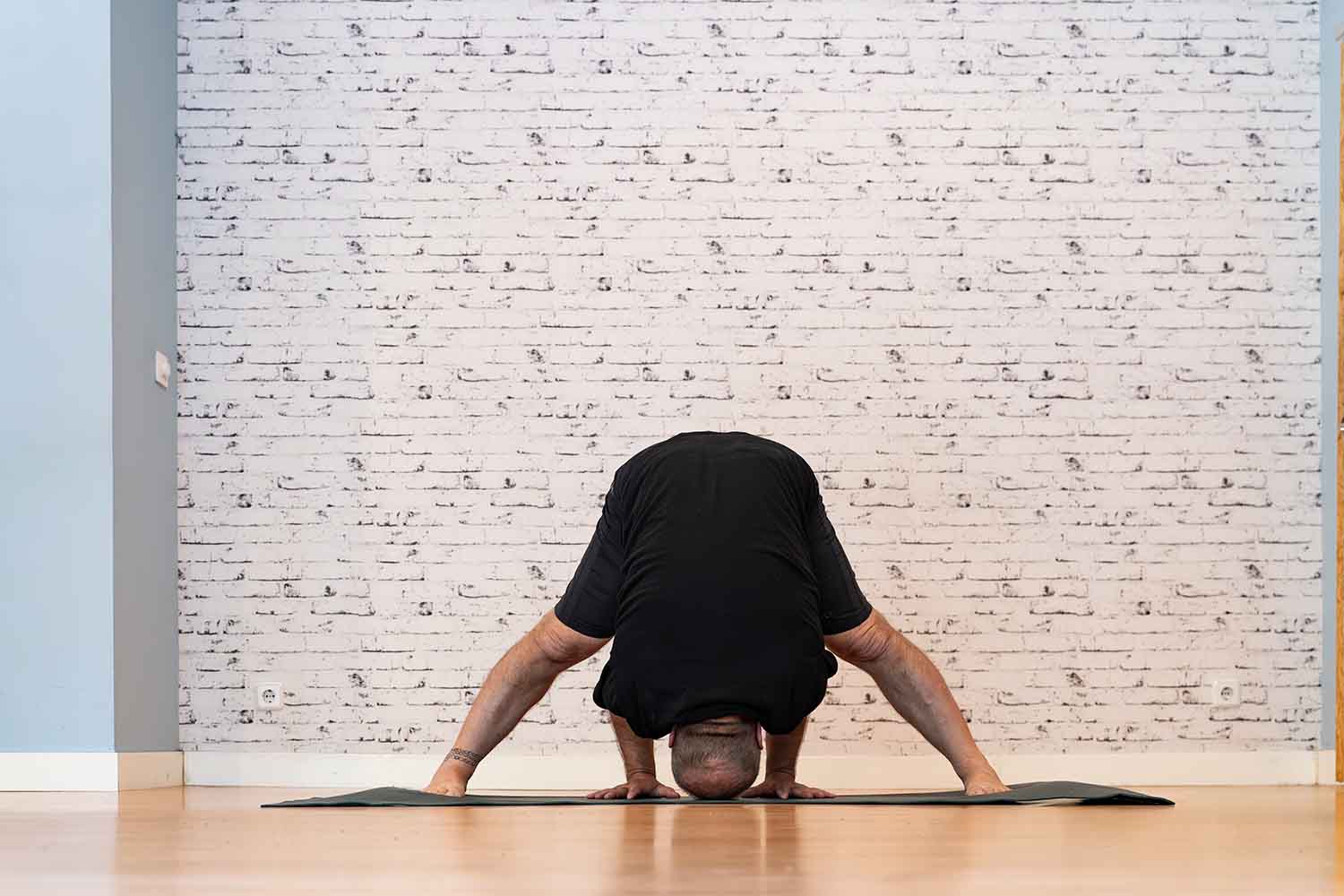Wide-Legged Forward Bend Pose in yoga (Prasarita Padottanasana) is a rejuvenating standing forward fold that stretches the hamstrings, inner thighs, and spine. This pose encourages relaxation while strengthening the legs and improving balance. It’s commonly used to relieve tension in the lower back and to prepare the body for deeper forward bends and inversions.
Other Names for Wide-Legged Forward Bend Pose
- Prasarita Padottanasana
- Wide-Legged Forward Fold
- Wide-Stance Forward Bend
How to Do Wide-Legged Forward Bend Pose in Yoga
Follow these steps to perform Prasarita Padottanasana:
- Begin in Mountain Pose (Tadasana), then step your feet wide apart, about 3 to 4 feet, depending on your height and flexibility.
- Inhale to lift your chest and engage your core. Place your hands on your hips and ensure your toes point slightly inward and heels outward, maintaining the outer edges of your feet parallel to the mat.
- Exhale and hinge forward at the hips, keeping your spine long as you fold your torso down between your legs.
- Place your hands on the floor beneath your shoulders or grab your big toes with your fingers. You can also rest your hands on blocks for added support.
- Allow your head to hang toward the mat, with your neck relaxed. Keep your weight evenly distributed between both feet.
- Hold the pose for several breaths, deepening the stretch with each exhale. Engage your thighs and lift your kneecaps to maintain strong legs.
- To exit, bring your hands to your hips, engage your core, and slowly rise up with a long spine.
Variations of Wide-Legged Forward Bend Pose
Experiment with these variations to adapt the pose to your level:
- Hands on Blocks: If reaching the floor feels challenging, place your hands on blocks at any height to maintain spinal length and reduce strain.
- Twisting Variation: From the forward fold, place one hand in the center of your mat and reach the other arm up toward the ceiling, twisting through your spine. This variation adds a spinal twist and opens the chest.
- Head-to-Floor Variation: For a deeper stretch, walk your hands back and aim to rest the crown of your head on the mat. This variation requires greater flexibility in the hamstrings and spine.
Modifications for Wide-Legged Forward Bend Pose
Use these modifications to make the pose more accessible:
- Bend the Knees: If your hamstrings feel tight or you experience lower back discomfort, bend your knees slightly to protect the spine and release tension in the legs.
- Widen the Stance: Step your feet wider apart to create more space in the fold, which can help ease tightness in the inner thighs and hips.
- Support with a Chair: Rest your hands or forearms on the seat of a chair for additional support, allowing you to maintain the fold without overstretching.
Contraindications for Wide-Legged Forward Bend Pose
Consider these contraindications before practicing this pose:
- Lower Back Injuries: Those with lower back issues should avoid rounding the spine and may want to practice with a slight bend in the knees or use props to keep the back flat.
- Hamstring Strains: If you have a hamstring injury, proceed cautiously and avoid overstretching the back of the legs.
- High or Low Blood Pressure: Forward bends can affect blood pressure. If you experience dizziness or discomfort, come out of the pose slowly or keep the head elevated using blocks or props.
- Pregnancy: As the belly grows, wide-legged forward folds may become uncomfortable. Pregnant practitioners should use a chair or blocks to support the upper body and reduce the depth of the fold.
Tips to Improve Wide-Legged Forward Bend Pose in Your Practice
To refine your practice in Prasarita Padottanasana, apply these helpful tips:
- Engage the Thighs: Press firmly into the outer edges of your feet and engage your thighs to protect your knees and avoid collapsing into the lower body.
- Lengthen the Spine: Focus on maintaining length through the spine as you fold, rather than forcing the depth of the forward bend. A long spine will enhance the benefits and reduce strain.
- Use the Breath: On each inhale, find more length through the crown of your head, and with each exhale, deepen your fold while maintaining a strong core.
- Relax the Neck: Allow your head and neck to hang freely, releasing any tension in the upper body. Avoid holding or tightening your neck muscles during the pose.
- Activate the Core: Engaging the core will help protect your lower back and ensure a smooth transition when rising from the forward fold.
What Muscles Does Wide-Legged Forward Bend Pose Work?
Prasarita Padottanasana engages and stretches various muscle groups:
- Hamstrings: This deep fold stretches the hamstrings, improving flexibility and releasing tension along the backs of the legs.
- Inner Thighs (Adductors): The wide-legged stance stretches the inner thighs, enhancing hip flexibility and balance.
- Spine (Erector Spinae): Lengthening the spine in the forward fold helps to stretch and release tension in the muscles along the back, promoting better posture.
- Calves: The forward bend provides a stretch to the calf muscles, increasing flexibility in the lower legs.
- Quadriceps: The quads engage to support the legs and maintain stability throughout the pose.
Mental and Emotional Benefits of Wide-Legged Forward Bend Pose
Wide-Legged Forward Bend offers significant mental and emotional benefits:
- Calming the Mind: As a gentle inversion, this pose helps calm the nervous system and reduce stress, promoting a sense of mental clarity.
- Relieving Anxiety: The inward focus of the forward fold encourages introspection, which can help alleviate anxiety and tension, leading to a calmer state of mind.
- Promoting Mindfulness: Focusing on the breath and body alignment in the pose enhances mindfulness, allowing you to stay present and grounded.
- Encouraging Emotional Release: The forward bend creates an opportunity to release stored physical and emotional tension, leaving practitioners feeling lighter and more centered.
Is Wide-Legged Forward Bend Pose Suitable for Beginners?
Yes, Prasarita Padottanasana can be modified for beginners with simple adjustments:
- Use Props: Beginners can place their hands on blocks or a chair to maintain stability and avoid overstretching.
- Keep a Slight Knee Bend: If your hamstrings feel tight, bend your knees slightly to prevent strain in the lower back and legs.
- Focus on Alignment: Prioritize maintaining a long spine and even weight distribution in the feet rather than pushing for a deep fold.
With these modifications, beginners can safely practice Wide-Legged Forward Bend and gradually build flexibility and strength.

Is Wide-Legged Forward Bend Pose Suitable for Advanced Practitioners?
Advanced practitioners can deepen their experience of Prasarita Padottanasana through enhanced alignment and advanced variations:
- Deeper Fold: Aim to bring the crown of your head to the floor or your chin to the mat, provided your spine remains long and your legs stay strong.
- Arm Variations: Experiment with clasping your hands behind your back and lifting them overhead to intensify the stretch across your shoulders and chest.
- Twisting Variations: Add a spinal twist by reaching one arm up toward the ceiling, expanding the chest and increasing mobility in the spine.
- Engage the Bandhas: Advanced students can incorporate Uddiyana Bandha (abdominal lock) to deepen the forward fold and enhance core engagement.
These refinements offer a greater challenge to flexibility, strength, and balance, providing deeper physical and mental benefits.
How Does Wide-Legged Forward Bend Pose Contribute to a Yoga Sequence?
Wide-Legged Forward Bend can be strategically placed in yoga sequences for various purposes:
- Transition Pose: Prasarita Padottanasana serves as an effective transition between standing postures and seated or supine poses, offering a moment of grounding.
- Counterpose to Backbends: After intense backbends, Wide-Legged Forward Bend provides a soothing counter-stretch that releases tension in the spine.
- Hamstring Opener: It can be included mid-sequence to open the hamstrings, preparing the body for deeper forward folds or standing balances.
- Inversion Alternative: As a gentle inversion, this pose promotes relaxation and can be practiced toward the end of a sequence to calm the mind before savasana.
How Can I Deepen My Practice in Wide-Legged Forward Bend Pose?
To deepen your practice in Prasarita Padottanasana, focus on the following techniques:
- Increase Hamstring Flexibility: Incorporate additional hamstring stretches like Downward Dog or Forward Fold to gradually build flexibility in the legs.
- Engage the Core: Use your core to support your lower back throughout the fold, ensuring stability as you deepen the stretch.
- Explore Variations: Try clasping your hands behind your back and lifting them overhead, or add a twist by lifting one arm up toward the ceiling.
- Hold the Pose Longer: Gradually increase the duration of the hold, allowing your body to release further with each breath and deepening the forward fold over time.
- Use the Breath: Sync your breath with the pose, inhaling to create length in the spine and exhaling to deepen the fold.
With these approaches, you will advance your practice safely and mindfully.
Common Mistakes in Teaching Wide-Legged Forward Bend Pose
Correct these common teaching mistakes to help students practice safely and effectively:
- Rounding the Back: Encourage students to keep a long spine by folding from the hips rather than rounding their back.
- Overextending the Hamstrings: Overstretching can lead to injury. Guide students to engage their thighs and keep a micro-bend in their knees if needed.
- Neglecting Foot Alignment: Remind students to distribute their weight evenly between the feet and keep the outer edges of their feet parallel to the mat.
- Forcing the Fold: Advise students to focus on lengthening the spine rather than forcing their head toward the floor.
By addressing these issues, instructors can help students build a safe, sustainable practice in Wide-Legged Forward Bend Pose.

